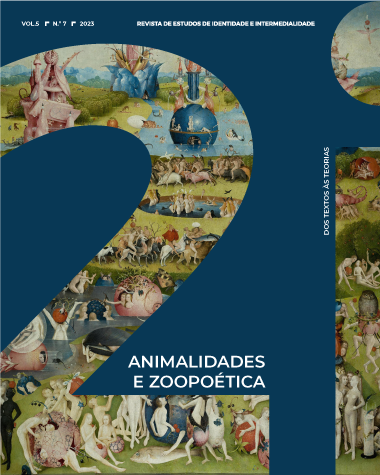Learning with pocket gophers
Porous ecologies and the resurgence of infested worlds of vitality
DOI:
https://doi.org/10.21814/2i.4504Keywords:
ecologies of proximity, multispecies studies, landscape, human-animal relations, vitalismAbstract
In this essay, I use a non-anthropocentric –more-than-human– perspective to tell a story about human-pocket gophers’ interactions in the rural territory of San Gerardo de Oreamuno, in northern zone of Cartago province, in Costa Rica. I’m interested in multispecies studies as an emerging agenda, which can be used for promoting reflection on contemporary views of rural development and socio-ecological challenges. Final considerations are concerned with modes of (co)existence that are active but unstable. Plots of land used for farmers to cultivate cauliflower and broccoli are multispecies zones of contact. Humans and pocket gophers, alongside other wild animals, technical devices, and abiotic elements of ecosystem are part of an entangled web of life, resistance, and death. Learning-with pocket gophers is to be sensitive to these infested words of vitality, where ambiguity and complexity can be seen as constitutive conditions of these modes of relationships.
Downloads
References
Alfaro, A. (1911). La destrucción de la taltuza. Boletín de Fomento, 1 (6), 456-463.
Araujo, A. (2022, Dizembro 1). O futuro é multiéspecie. Quatro cinco um. Consultado em: https://quatrocincoum.folha.uol.com.br/br/resenhas/os-melhores-livros-de-2022/o-futuro-e-multiespecie
Bateson, G. (1972). Steps to an Ecology of Mind: Collected essays in anthropology, psychiatry, evolution, and epistemology. San Francisco, CA: Chandler.
Bingham, N. (2006). Bees, butterflies, and bacteria: Biotechnology and the politics of nonhuman friendship. Environment and Planning A, 38 (3), 483-498. DOI: https://doi.org/10.1068/a38436
Bonino, N. (1993). Características físicas y reproductivas de la taltuza Orthogeomys heterodus (Rodentia: Geomyidae) en Costa Rica. Brenesia, 39-40, 29-35.
_____ (1995). La taltuza en la zona hortícola del norte de Cartago, Costa Rica. Manejo Integrado de Plagas y Agroecología, 37, 57-60.
Bonino, N., y Hilje, L. (1992). Estimación de la abundancia de la taltuza Orthogeomys heterodus (Rodentia, Geomyidae) y del daño producido en una zona hortícola de Costa Rica. Manejo Integrado de Plagas y Agroecología, 23, 26-31.
Boonman‐Berson, S., Driessen, C. and Turnhout, E. (2019). Managing wild minds: From control by numbers to a multinatural approach in wild boar management in the Veluwe, the Netherlands. Transactions of the Institute of British Geographers 44 (1), 2-15. DOI: https://doi.org/10.1111/tran.12269
Bradic M (2019). Towards a poetics of weird biology: Strange lives of nonhuman organisms in literature. Pulse, 1, 1–22.
Carter, S., and McCormack, D.P. (2006). Film, geopolitics and the affective logics of intervention. Political Geography, 25, 228–245. DOI: https://doi.org/10.1016/j.polgeo.2005.11.004
Chavarría-Chang, A. y Monge, J. (2020). Impacto de la taltuza, Heterogeomys underwoodi (Rodentia: Geomyidae) en la producción agrícola de Puriscal, Costa Rica. Cuadernos de Investigación UNED, 12 (1), 54-64. DOI: https://doi.org/10.22458/urj.v12i1.2810
Dávila Meneses, A., Quintanilla Retana, F., Castillo Araya, K., Sánchez Ortiz, L., Barquero Uriarte, T., y Romero Zúñiga, J. J. (2018). Caracterización clínica y epidemiológica de la población tamizada en el centro de detección temprana de cáncer gástrico, Costa Rica: período 1996-2015. Revista Costarricense de Salud Pública, 27 (2), 68-81.
Deleuze, G., and Guattari, F. (1987). A thousand plateaus: Capitalism and schizophrenia. Minneapolis, MN: University of Minnesota Press.
Ellis, R. (2021). Sensuous and spatial multispecies ethnography as a vehicle to the re-enchantment of everyday life: A case study of knowing bees. In: Hovorka, A. et al. (eds.), A Research Agenda for Animal Geographies. Massachusetts, Edward Elgar Publishing, 87-100. DOI: https://doi.org/10.4337/9781788979993.00013
Flores Sandí, G. (1995). Intoxicación por estricnina en Costa Rica. Medicina Legal de Costa Rica, 11 (2-1), 50-52.
Foro Emaus (2000). Por la prohibición del Paraquat en Costa Rica. [versión online] Recuperado de: https://members.tripod.com/foro_emaus/paraquat.htm
Haraway, D. J. (2013). When species meet. United States: University of Minnesota Press.
_____ (2020). Seguir con el problema: Generar parentesco en el Chthuluceno. España: Consonni.
Horacio. (2018). Epodos. Odas. Madrid: Edhasa.
Kohn, E. (2021). Cómo piensan los bosques: Hacia una antropología más allá de lo humano. Ecuador: Abya-Yala.
Martín Arribas, J. J. (2022). El deterioro de la capa de ozono como asunto global pendiente de resolución. Revista Española de Derecho Internacional, 74 (2), 323-348. DOI: https://doi.org/10.17103/redi.74.2.2022.1b.08
Monge, J. (2010). Distribución geográfica, características y clave taxonómica de las taltuzas (Orthogeomys spp., Rodentia: Geomyidae) en Costa Rica. Cuadernos de Investigación UNED, 2 (1), 23-31. DOI: https://doi.org/10.22458/urj.v2i1.219
_____ (2018). Pasado, presente y futuro del manejo de vertebrados plaga en Costa Rica. Revista de Ciencias Ambientales, 52 (1), 221-238. DOI: https://doi.org/10.15359/rca.52-1.13
Monge-Meza, J. (2011). El impacto de las taltuzas en el cultivo de banano. Agronomía mesoamericana, 22 (1), 167-174. DOI: https://doi.org/10.15517/am.v22i1.8680
Pink, S. (2009). Doing Sensory Ethnography. Sage: London. DOI: https://doi.org/10.4135/9781446249383
Pomareda, F. (2021, Setiembre 1). Sala IV acoge recurso contra Gobierno por frenar decreto para prohibir plaguicida paraquat. Semanario Universidad. Recuperado de: https://semanariouniversidad.com/pais/sala-iv-acoge-recurso-contra-gobierno-por-frenar-decreto-para-prohibir-plaguicida-paraquat/
Sisk, T. D., y Vaughan-Dickhaut, C. (1984). Apuntes sobre algunos aspectos de la historia natural de la taltuza gigante (Orthogeomys Merrian) en Costa Rica. Brenesia, 22, 233-247.
Sutherland, D.; Vaughn, C.; y Chavez, A. (1989). Control de la taltuza en Costa Rica. [Plegable]. Universidad Nacional. Heredia, Costa Rica.
Tsing, A. L. (2017). A threat to Holocene resurgence is a threat to livability. In Brightman, M. y Lewis, J. (Ed.), The anthropology of sustainability (p. 51-65). New York: Palgrave Macmillan. DOI: https://doi.org/10.1057/978-1-137-56636-2_3
_____ (2021). La seta del fin del mundo: Sobre la posibilidad de vida en las ruinas capitalistas. Madrid: Capitán Swing.
Vitellone, N.; Mair, M; and Kierans, C. (2021). Doing things with description: Practices, politics, and the art of attentiveness. Qualitative Research, 21 (3), 313-323. DOI: https://doi.org/10.1177/1468794120975972
Winterson, J. (1997). Gut symmetries. New York: Vintage.
Downloads
Published
How to Cite
Issue
Section
License
Copyright (c) 2023 Luis Barboza

This work is licensed under a Creative Commons Attribution-NonCommercial 4.0 International License.


.jpg)










